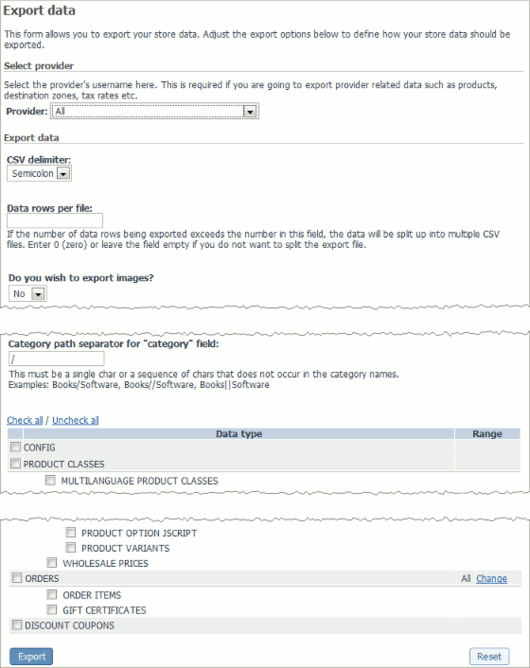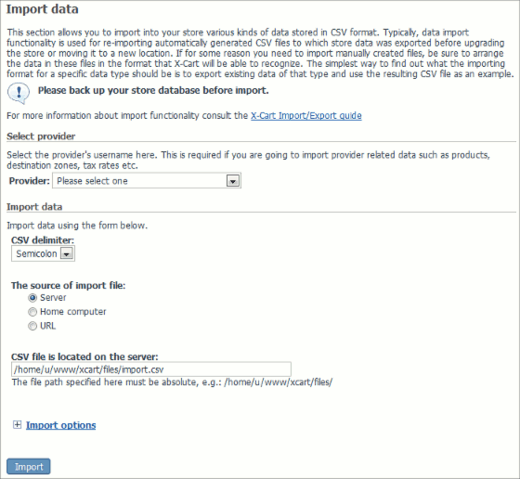Difference between revisions of "X-Cart:Importing and Exporting Data"
(→Import/Export procedures in X-Cart) |
|||
| Line 3: | Line 3: | ||
X-Cart 4.3.x features export and import of almost all X-Cart data types. Export and import procedures facilitate the updating of your store data and allow you to consistently transfer data when upgrading your store or moving it to a new location. | X-Cart 4.3.x features export and import of almost all X-Cart data types. Export and import procedures facilitate the updating of your store data and allow you to consistently transfer data when upgrading your store or moving it to a new location. | ||
| − | Basic information on export procedures is available in the section [[#Exporting Data]], import procedures - in the section [[#Importing Data]]. | + | Basic information on export procedures is available in the section [[#Exporting Data | Exporting Data]], import procedures - in the section [[#Importing Data | Importing Data]]. |
| − | Detailed information on X-Cart import and export can be found in the | + | Detailed information on X-Cart import and export can be found in the [[X-Cart:Import-Export_Guide | Import/Export Guide]] |
== Roles in Import/Export management == | == Roles in Import/Export management == | ||
Revision as of 14:48, 24 March 2010
Contents
Import/Export procedures in X-Cart
X-Cart 4.3.x features export and import of almost all X-Cart data types. Export and import procedures facilitate the updating of your store data and allow you to consistently transfer data when upgrading your store or moving it to a new location.
Basic information on export procedures is available in the section Exporting Data, import procedures - in the section Importing Data.
Detailed information on X-Cart import and export can be found in the Import/Export Guide
Roles in Import/Export management
If you are an X-Cart GOLD administrator/provider, you can import and export:
- config data,
- states,
- users,
- categories (including international category descriptions),
- products (including international product descriptions, featured products and product links),
- destination zones,
- taxes (including tax rates),
- shipping rates,
- orders (export only, including order items),
- other types of data (depending on the set of enabled modules and add-ons).
If you are an X-Cart PRO administrator, you can import and export all types of X-Cart data:
- config data,
- states,
- users,
- categories (including international category descriptions),
- products (including international product descriptions, featured products and product links),
- destination zones,
- taxes (including tax rates),
- shipping rates,
- orders (export only, including order items),
- other types of data (depending on the set of enabled modules and add-ons).
If you are an X-Cart PRO provider, you can import and export:
- your products (including international product descriptions and product links),
- your destination zones,
- your tax rates,
- your shipping rates,
- your orders (export only, including order items),
- other types of data according to your access privileges (depending on the set of enabled modules and add-ons).
Exporting Data
Export of X-Cart data can be performed using the 'Export data' section of your store's back end.
To access this section:
- Go to the 'Import/export data' section of your store's back end: click the link Import/Export in the Management menu.
- In the 'Import/export data' section menu, click the link Export data.
The 'Export data' section looks something like this (with the reservation that the section [+] Select provider is available only to X-Cart PRO administrators, and the set of data types available for exporting varies on the type of user account being used):
To export data to a CSV file:
- Use the settings of the 'Export data' dialog box to specify, what data you wish to be exported and how you wish that to be done:
- (If you are an X-Cart PRO administrator) If you wish to export not all the data, but just the data of a specific provider, specify the username of the provider whose data you wish to export: expand the 'Select provider' subsection of the 'Export data' dialog box by clicking the [+] Select provider link, enter the username of the provider into the appropriate field and click the Go button.
- Use the 'CSV delimiter' drop-down box to select a delimiter that you wish to be used in the resulting CSV file (Semicolon, Comma, Tab).
- If you wish the export spreadsheet to be split into several portions (each in a separate file), use the 'Data rows per file' field to specify the maximum number of data rows which may be contained in one file. Leave the field empty or enter 0 (zero) if you do not want to split the export file.
- Specify, whether you wish to export images (Yes/No).
- Use the field 'Category path separator for "category" field' to type in a character or a sequence of characters that you wish to be used as the 'category' field separator in the export CSV file. You can use any character or sequence of characters that does not occur in the category names.
- Select the data that needs to be exported:
- If you are going to export USERS, PRODUCTS or ORDERS, adjust the respective data ranges (use the links in the RANGE column).
- Select the types of data that need to be exported (select the check boxes next to the names of these types).
- Click the Export button at the bottom of the 'Export data' dialog box. X-Cart should start exporting the data. Export packs will be saved to the directory /xcart/var/tmp.
As soon as the export process is completed, you should see an Information box with a confirmation message and a link to the export packs. - Click the Export packs link in the Information box or scroll down to the bottom of the 'Export data' section. You should see a new subsection in the 'Export data' dialog box - 'Export packs' - listing the CSV files created as a result of exporting procedure.
- Download the export pack files onto your local machine by clicking the filename links.
If you wish to remove export packs from the directory to which they are saved by X-Cart (/xcart/var/tmp), you can delete them using X-Cart interface.
To delete export packs:
- Expand the 'Export packs' subsection of the 'Export data' dialog box.
- Select the check boxes next to the export packs that need to be removed.
- Click the Delete selected button. The selected export packs should be removed. You should see an Information box with a confirmation message.
Importing Data
Import of X-Cart data can be performed using the 'Import data' section of your store's back end.
To access this section:
- Go to the 'Import/export data' section of your store's back end: click the link Import/Export in the Management menu.
- In the 'Import/export data' section menu, click the link Import data.
The 'Import data' section looks like this (with the reservation that the section [+] Select provider is available only to X-Cart PRO administrators, and the set of data types available for importing varies depending on the type of user account being used):
To import data into X-Cart:
- Prepare a CSV file for import. Make sure it contains all the necessary required fields (For a list of fields that are required for a specific data type, refer to the table in the 'Import options' section of the 'Import data' dialog box (accessible by clicking the link [+]Import options). Make sure the types of data you are going to import are listed in the table (If not, ensure that the modules/add-ons that use these types of data are enabled).
- Use the settings of the 'Import data' dialog box to specify, what data you wish to be imported and how you wish that to be done:
- (If you are an X-Cart PRO administrator) Certain types of X-Cart data (like PRODUCTS, SHIPPING RATES, TAX RATES, etc) are not displayed and cannot be imported without an indication of which provider they belong to. If you are importing provider-specific data, be sure to specify the username of their owner: expand the 'Select provider' subsection of the 'Import data' dialog box by clicking the [+] Select provider link, enter the username of the provider into the appropriate field and click the Go button.
- Use the 'CSV delimiter' drop-down box to select a delimiter that is used in the CSV file which you are going to import (Semicolon, Comma, Tab).
- Specify the source of the import file:
- Select the appropriate radio button to specify, whether the CSV file is located on the server where your X-Cart is installed, on your local machine or some web-accessible location (Server, Home computer, URL).
- Depending on the location selected, provide a file path or a URL.
- Expand the section 'Import options' by clicking the [+] Import options link and adjust the settings in this section:
- If you are importing users, specify, whether customer passwords are encrypted (Yes/No).
- If you are importing products, set the Default category (a category where your products will go if you did not specify a category in the 'Category' column. Just leave this field alone if you have specified a category in your CSV file).
- If your CSV file contains mention of subcategories (for example, if some of the products being imported will go to subcategories), make sure the Category path separator for "category" field specified in the 'Import options' section is exactly the same as the separator used in your CSV file.
- If you are importing images (thumbnail images, product images, category icons, etc) and wish to import them from a single directory, specify this directory as Directory where images are located.
- If your store database already contains data of the types that you are going to import, and you wish to drop this data before importing data from your spreadsheet, select the DROP check boxes next to the names of data types that need to be dropped. (If you do not select any check boxes, the data from your spreadsheet will simply be added to the database).
- Click the Import button at the bottom of the 'Import data' dialog box. X-Cart should start importing the data.
As soon as the import process is completed, you should see an Information box with a confirmation message.